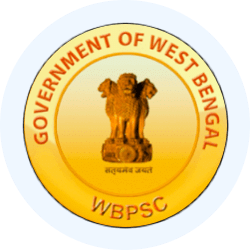WBCS (West Bengal) Exam > WBCS (West Bengal) Notes > WBCS Preparation: All Subjects > Physiographic Division of the State
Physiographic Division of the State | WBCS Preparation: All Subjects - WBCS (West Bengal) PDF Download
West Bengal comprises predominantly flat and featureless alluvial plains, with Southern Bengal primarily consisting of the Ganga River delta. The state exhibits diverse topography, with 1% characterized by mountainous terrain, 6% forming a plateau fringe, and the Purulia triangle creating uplands along the western border. The physiographic division of West Bengal includes the Northern Mountain Region, the Western Plateau Fringe, and the Plains, further subdivided into the Northern and Southern Plains.
The Northern Mountain Region
- The Northern Mountain Region encompasses the entire Darjeeling district, excluding Siliguri division, and parts of the Jalpaiguri district. Comprising predominantly hilly landscapes with sedimentary and metamorphic rocks, this region faces challenges such as high terrain, steep gradients, and heavy rainfall ranging from 80 to 160 inches. Notable peaks in this area include Sandakphu, Phalut, Soborgram, and Tannglu, with Sandakphu standing as the highest peak in West Bengal. The Teesta, Jaldhaka, and Raidhak rivers flow through, with the Teesta creating deep gorges that divide the region into Western and Eastern Mountain Regions.
- In the Western Mountain Region, significant ranges include the Singalila range and Darjeeling range, the latter extending from the Terai region in the South to steep mountains in the North. The renowned Darjeeling Toy Train traverses this region from Siliguri to Darjeeling, passing through Ghum, the highest railway station globally. Tiger range, the highest peak in the Darjeeling range, offers a stunning view of Mt. Kanchenjunga. Notable peaks in this area include Sandakphu, Phalut, Sabargram, and Tonglu, with the ancient Silk Route passing through Pedong city near Kalimpong.
- The Eastern Mountain Region features Richila as its highest peak, and the Sinchula range forms the boundary between Bhutan and Jalpaiguri. The Buxa pass serves as a significant mountain pass connecting India and Bhutan, with prominent peaks like Renigango and Chota Sinchula in this region.
The Western Plateau Fringe
The Western Plateau Fringe comprises ancient igneous rocks such as granite and gneiss from the Archaean era, along with coal-bearing mudstone and quartzite rocks from the Carboniferous period. Due to prolonged erosion, the entire region has transformed into an undulating peneplain, dotted with small monadnocks referred to locally as 'tila.' These rocky plains slope eastward, blending with the higher slope of the alluvial plain. This plateau fringe, connecting Bihar's Rajmahal hills and the Chotanagpur plateau, is a rolling upland featuring isolated hills like Ayodhya and Baghmundi in the Purulia district. Numerous rainfed rivers originate from the Chotanagpur Plateau, characterized by short courses.
Plains
- The Plains region, extending from Siliguri to the Bay of Bengal coast, constitutes the largest portion of West Bengal and contributes to its agricultural fertility. Excluding the northern hilly and western plateau areas, the rest of the region is primarily plain. The Ganga River, flowing west to east, divides the plain into northern and southern sections.
- In North Bengal, the Terai region, also known as duars, is composed of sand, gravel, and pebbles carried by various rivers. The Northern Plains, extending from the southern Terai to the northern bank of the Ganges, include Diara (new alluvium in the western part of Malda district), Barendrabhumi (old alluvium in South West Dinajpur and North-East Malda), and Tals (floodwater-created lakes). The Mahananda Corridor, running north to south, connects Malda with the plains of Jalpaiguri and Cooch Behar.
- The Mahananda River divides Malda into eastern Barind or Barendrabhumi (undulating plains of old alluvium) and western fertile diara areas. The western plain is mainly formed by silt from the western tributaries of the Bhagirathi River, while the southern plains between Bhagirathi and the Bangladesh border feature shallow lakes, marshes, and river courses, offering fertile land for agriculture.
- In South Bengal, the Ganges forms a delta with three distinct parts: old, mature, and active delta plains. The Moribund Delta plains in Nadia and the eastern part of Murshidabad constitute the completely formed delta. The Mature Delta Plain includes Hooghly, Howrah, Burdwan, and East Midnapore, while the Active Delta Plain in South 24-Parganas and North 24 Parganas is an ongoing delta formation area.
- The Rahr Plain, situated between the delta and the western plateau, is characterized by predominantly silt-formed land with red laterite soil. Eastern Bankura, Bardhaman, Birbhum, Western Murshidabad, and West Midnapore lie in this region. The Sandy Coastal Plain along the Bay of Bengal in East Midnapore consists mainly of sand and mud deposited by rivers and wind, with Digha and Kanti as significant sea breaches.
- Lastly, the Sunderbans Plains are alluvial lowlands characterized by muddy and saline water, numerous tributaries, islands, and estuaries, primarily covered by the Sunderbans, the world's largest mangrove forest declared a UNESCO World Heritage Site in 1987.
The document Physiographic Division of the State | WBCS Preparation: All Subjects - WBCS (West Bengal) is a part of the WBCS (West Bengal) Course WBCS Preparation: All Subjects.
All you need of WBCS (West Bengal) at this link: WBCS (West Bengal)
|
77 videos|109 docs
|

|
Explore Courses for WBCS (West Bengal) exam
|

|
Signup for Free!
Signup to see your scores go up within 7 days! Learn & Practice with 1000+ FREE Notes, Videos & Tests.
Related Searches
















